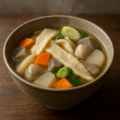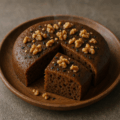まめぶ汁の特徴
甘じょっぱい「くるみ餡」を包んだ団子が主役の岩手・久慈の郷土汁
「まめぶ汁」は、くるみ+砂糖の小さな餡(まめぶ)を小麦生地で包み、根菜やきのこを煮た醤油仕立ての汁に落として煮る一椀。噛むと中からほろっと甘じょっぱい香ばしさが広がり、素朴ながらも印象的な味があります。
だし×根菜に“まめぶ”が溶け合う
昆布やかつお節のだしに、ごぼう・にんじん・しいたけ・長ねぎなど。団子の表面が汁をまとい、中のくるみ糖が少し溶け出してコクを添えます。
祝い・人寄せのごちそう
岩手県北~久慈周辺で、ハレの日の人寄せや行事のもてなしに親しまれてきた郷土の味。家ごとに甘さや具、団子の大きさに“我が家の流儀”があります。
まめぶ汁のレシピ
材料(4人分)
- まめぶ(団子)生地:薄力粉 150g/塩 ひとつまみ/水 80〜100ml(様子を見て)
- 中のくるみ糖:くるみ 40g(軽く煎って粗みじん)/砂糖 15g(黒糖や上白糖、お好みで)
- 具:ごぼう 1/2本(ささがき)/にんじん 1/2本(半月切り)/生しいたけ 3枚(薄切り)/木綿豆腐 1/2丁(1.5cm角・任意)/長ねぎ 1本(小口切り、仕上げ用)
- だし・調味:だし 1,000ml(昆布+かつお)/醤油 大さじ2〜3/みりん 大さじ1/酒 大さじ1/塩 少々
作り方
- くるみ糖:くるみを乾煎りして粗く刻み、砂糖と混ぜて8〜10等分の小粒にまとめる。
- 生地:薄力粉と塩を混ぜ、水を少しずつ加えて耳たぶ程度にこねる。ラップで包み20〜30分休ませる。
- 包む:生地を8〜10等分。1個ずつ丸くのばして中央にくるみ糖を入れ、口をしっかり閉じて丸める。
- 汁を煮る:鍋にだしを沸かし、ごぼう・にんじん・しいたけを入れて中火で5〜6分。醤油・みりん・酒で調味。
- 団子を煮る:沸いた汁に団子を静かに落とし、弱めの中火で5〜7分。表面が透け、浮いてきたら豆腐・長ねぎを加え1〜2分。塩で味を整える。
- 仕上げ:火を止めて、椀によそう。
シェフのワンポイントアドバイス
- 団子の口はしっかり閉じる(煮崩れ防止)。生地が乾くと割れやすいので手早く包みましょう。
- くるみは軽く煎ると香りが段違い。甘さは砂糖量で調整を。
- だしはやや控えめの味にし、団子の甘じょっぱさでバランスを取ると上品に仕上がります。
栄養価(1杯の目安)
- エネルギー:約280〜420 kcal
- たんぱく質:8〜14 g
- 脂質:6〜12 g
- 炭水化物:45〜60 g
歴史
“人が集まる席”のあたたかい一椀
北東北の粉食文化の中で、くるみの滋味と砂糖のごちそう感を生かした団子入り汁として発達。久慈・野田・普代などで受け継がれ、今も行事のもてなしに欠かせません。
English Version
Features of Mamebu-jiru (Kuji, Iwate)
Dumplings filled with sweet-savory walnut paste
Mamebu-jiru is a local soup from Kuji, Iwate: small dumplings stuffed with a mixture of walnuts and sugar (“mamebu”) are wrapped in wheat dough, then simmered in a soy-based broth with roots and mushrooms. Bite in and a gently sweet-salty nuttiness spreads through the broth—simple yet memorable.
Broth, roots, and “mamebu” meld into one
The soup uses kombu–katsuobushi dashi with burdock, carrot, shiitake, and leek. The dumpling surface carries the broth, while a little of the walnut sugar melts out to add body.
A celebratory, crowd-pleasing bowl
Across northern Iwate—especially around Kuji—this has long been served for festive gatherings. Sweetness, add-ins, and dumpling size vary by household.
Recipe
Ingredients (Serves 4)
- Dumpling dough: cake or all-purpose flour 150 g; salt a pinch; water 80–100 ml (as needed)
- Walnut sugar filling: walnuts 40 g (lightly toasted, coarsely chopped); sugar 15 g (brown or white)
- Soup add-ins: burdock 1/2 (shaved); carrot 1/2 (half-moons); fresh shiitake 3 (thinly sliced); firm tofu 1/2 block (1.5 cm cubes, optional); leek 1 (finely sliced for finishing)
- Broth & seasoning: dashi 1,000 ml (kombu + katsuobushi); soy sauce 2–3 Tbsp; mirin 1 Tbsp; sake 1 Tbsp; salt to taste
Instructions
- Walnut sugar: Dry-toast walnuts, chop coarsely, mix with sugar, and divide into 8–10 small nuggets.
- Dough: Mix flour and salt; add water gradually and knead to a soft “earlobe” texture. Wrap and rest 20–30 minutes.
- Fill: Divide dough into 8–10 pieces. Flatten each, place a walnut nugget in the center, seal tightly, and round.
- Start the soup: Bring dashi to a boil; add burdock, carrot, and shiitake. Simmer 5–6 minutes. Season with soy sauce, mirin, and sake.
- Cook dumplings: Gently drop dumplings into the simmering soup. Cook over medium-low 5–7 minutes, until slightly translucent and floating. Add tofu and leek; simmer 1–2 minutes. Adjust salt.
- Serve: Turn off the heat and ladle into bowls.
Chef’s Tips
- Seal dumplings well to prevent leaks; work briskly so the dough doesn’t dry and crack.
- Lightly toasting the walnuts boosts aroma; adjust sweetness by the sugar amount.
- Keep the broth moderately seasoned and let the dumplings’ sweet-savory filling complete the balance.
Nutritional Value (per bowl, approx.)
- Calories: 280–420 kcal
- Protein: 8–14 g
- Fat: 6–12 g
- Carbohydrates: 45–60 g
History
A warm bowl for gatherings
Within Tōhoku’s grain-based foodways, mamebu-jiru developed as a dumpling soup that couples the richness of walnuts with celebratory sweetness. In Kuji, Noda, and Fudai it remains a hallmark of hospitality for festive occasions.



何でも質問してください!